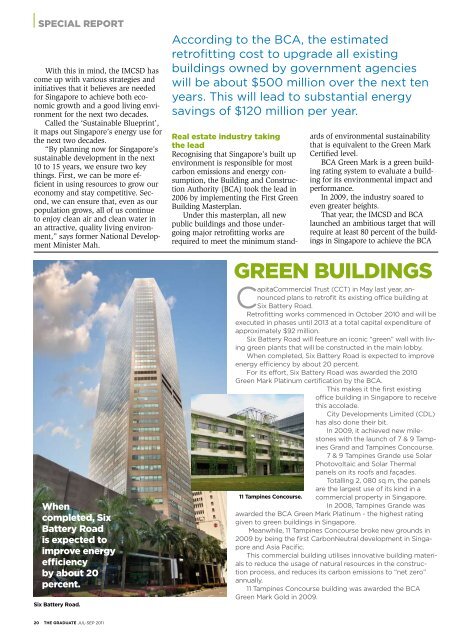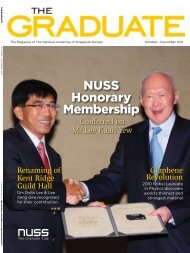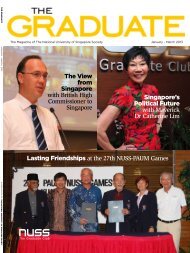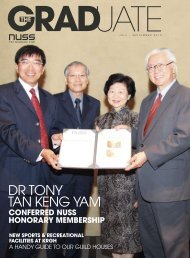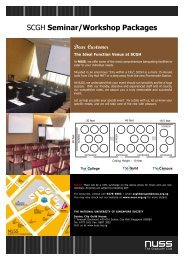NUss Distinguished & outstanding Member Awards
NUss Distinguished & outstanding Member Awards
NUss Distinguished & outstanding Member Awards
Create successful ePaper yourself
Turn your PDF publications into a flip-book with our unique Google optimized e-Paper software.
Special RepoRt<br />
With this in mind, the IMCSD has<br />
come up with various strategies and<br />
initiatives that it believes are needed<br />
for Singapore to achieve both economic<br />
growth and a good living environment<br />
for the next two decades.<br />
Called the ‘Sustainable Blueprint’,<br />
it maps out Singapore’s energy use for<br />
the next two decades.<br />
“By planning now for Singapore’s<br />
sustainable development in the next<br />
10 to 15 years, we ensure two key<br />
things. First, we can be more efficient<br />
in using resources to grow our<br />
economy and stay competitive. Second,<br />
we can ensure that, even as our<br />
population grows, all of us continue<br />
to enjoy clean air and clean water in<br />
an attractive, quality living environment,”<br />
says former National Development<br />
Minister Mah.<br />
When<br />
completed, Six<br />
Battery Road<br />
is expected to<br />
improve energy<br />
efficiency<br />
by about 20<br />
percent.<br />
Six Battery Road.<br />
20 THE GRADUATE Jul-Sep 2011<br />
According to the BCA, the estimated<br />
retrofitting cost to upgrade all existing<br />
buildings owned by government agencies<br />
will be about $500 million over the next ten<br />
years. This will lead to substantial energy<br />
savings of $120 million per year.<br />
Real estate industry taking<br />
the lead<br />
Recognising that Singapore’s built up<br />
environment is responsible for most<br />
carbon emissions and energy consumption,<br />
the Building and Construction<br />
Authority (BCA) took the lead in<br />
2006 by implementing the First Green<br />
Building Masterplan.<br />
Under this masterplan, all new<br />
public buildings and those undergoing<br />
major retrofitting works are<br />
required to meet the minimum stand-<br />
ards of environmental sustainability<br />
that is equivalent to the Green Mark<br />
Certified level.<br />
BCA Green Mark is a green building<br />
rating system to evaluate a building<br />
for its environmental impact and<br />
performance.<br />
In 2009, the industry soared to<br />
even greater heights.<br />
That year, the IMCSD and BCA<br />
launched an ambitious target that will<br />
require at least 80 percent of the buildings<br />
in Singapore to achieve the BCA<br />
GReeN BuildiNGS<br />
CapitaCommercial Trust (CCT) in May last year, announced<br />
plans to retrofit its existing office building at<br />
Six Battery Road.<br />
Retrofitting works commenced in October 2010 and will be<br />
executed in phases until 2013 at a total capital expenditure of<br />
approximately $92 million.<br />
Six Battery Road will feature an iconic “green” wall with living<br />
green plants that will be constructed in the main lobby.<br />
When completed, Six Battery Road is expected to improve<br />
energy efficiency by about 20 percent.<br />
For its effort, Six Battery Road was awarded the 2010<br />
Green Mark platinum certification by the BCA.<br />
This makes it the first existing<br />
office building in Singapore to receive<br />
this accolade.<br />
City Developments limited (CDl)<br />
has also done their bit.<br />
In 2009, it achieved new milestones<br />
with the launch of 7 & 9 Tampines<br />
Grand and Tampines Concourse.<br />
7 & 9 Tampines Grande use Solar<br />
photovoltaic and Solar Thermal<br />
panels on its roofs and façades.<br />
Totalling 2, 080 sq m, the panels<br />
are the largest use of its kind in a<br />
11 Tampines Concourse. commercial property in Singapore.<br />
In 2008, Tampines Grande was<br />
awarded the BCA Green Mark platinum - the highest rating<br />
given to green buildings in Singapore.<br />
Meanwhile, 11 Tampines Concourse broke new grounds in<br />
2009 by being the first CarbonNeutral development in Singapore<br />
and Asia pacific.<br />
This commercial building utilises innovative building materials<br />
to reduce the usage of natural resources in the construction<br />
process, and reduces its carbon emissions to “net zero”<br />
annually.<br />
11 Tampines Concourse building was awarded the BCA<br />
Green Mark Gold in 2009.


